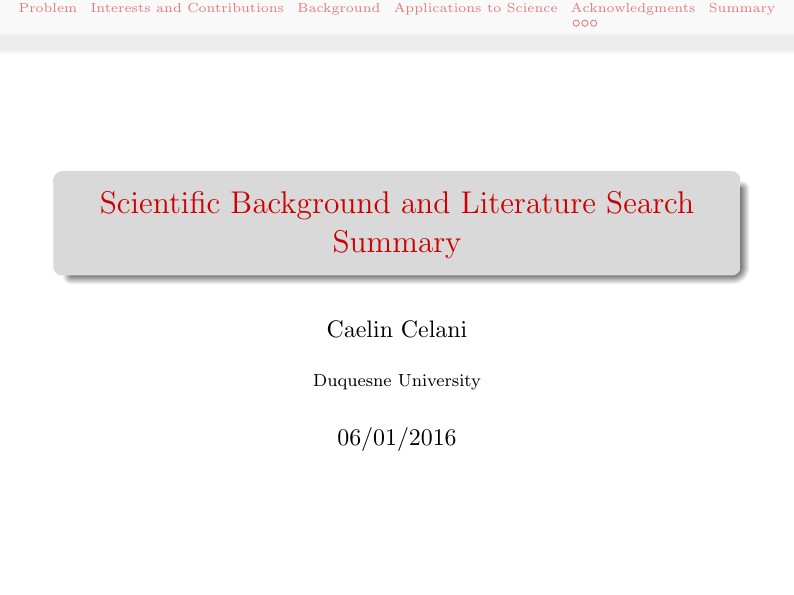
Phase 0 project: Test and Compare Current Literature of MB Water

\documentclass{beamer}
% Choose how your presentation looks.
%
% For more themes, color themes and font themes, see:
% http://deic.uab.es/~iblanes/beamer_gallery/index_by_theme.html
%
\mode<presentation>
{
\usetheme{Darmstadt} % or try Darmstadt, Madrid, Warsaw, ...
\usecolortheme{beaver} % or try albatross, beaver, crane, ...
\usefonttheme{serif} % or try serif, structurebold, ...
\setbeamertemplate{navigation symbols}{}
\setbeamertemplate{caption}[numbered]
}
\usepackage[english]{babel}
\usepackage[utf8x]{inputenc}
\title[Background and Literature]{Scientific Background and Literature Search Summary}
\author{Caelin Celani}
\institute{Duquesne University}
\date{06/01/2016}
\begin{document}
\begin{frame}
\titlepage
\end{frame}
% Uncomment these lines for an automatically generated outline.
%\begin{frame}{Outline}
% \tableofcontents
%\end{frame}
\section{Problem}
\begin{frame}{Test and Compare Current Literature of MB Water}
\begin{itemize}
\item Run simulations with 2D and 3D MB water to compare with current research
\item Compare to four state modified Muller Model used in Silverstein study \footnotemark[1]
\item Uses 4 physical states of bulk and shell water molecules surrounding a water molecule or nonpolar solvent.
\item Possible theoretical phase diagram to exhibit nteresting properties such as $_{(l)}\rightarrow_{(s)}$ transition with increasing pressure.
\begin{center}
\includegraphics[scale=.2]{Solvation_Diagram.png}
\end{center}
\footnotetext[1]{\tiny{Silverstein, K. A. T.; Haymet, A. J. D.; Dill, K. A. Molecular Model of Hydrophobic Solvation J. Chem. Phys. \textbf{1999}, 111(17), 8000-8009}}
\end{itemize}
\end{frame}
\section{Interests and Contributions}
\begin{frame}{For Science!}
\begin{itemize}
\item Will provide a detailed comparison of Monte Carlo and Molecular Dynamics simulations on MB water.
\item Will allow for a greater understanding of the physical properties of water.
\item Will test reproducibility of several published articles.
\end{itemize}
\end{frame}
\section{Background}
\begin{frame}{Why Study $H{_2}O$?}
\begin{itemize}
\item Water has many unusual features including high heat capacity ($C_p$), the hydrophobic effect, density anomalies (i.e. $d_{(s)}>d_{(l)}$ below $3.984^{o}$C), isothermal compressability, etc.
\begin{center}
\includegraphics[scale=.1]{oilwaterinbeaker.jpg}
\end{center}
\item Understanding of water leads to understanding of many other natural processes (e.g. Limitations in predicting protein structures and drug interatictions and are due to our understanding of water \footnotemark[1])
\item Importance in essentially all of science - wet chem, biologoy/biochem, environmental chem, $\cdots$
\footnotetext[1]{\tiny{Dill, K. A.; Truskett, T. M.; Vlachy, V.; Hribar-Lee, B. Modeling Water, The Hydrophobic Effect, \& Ion Solvation Annu. Rev. Biophys. Biomol. Struct. \textbf{2005}, 34, 179-199}}
\end{itemize}
\end{frame}
\begin{frame}{Mercedes Benz Water}
\begin{itemize}
\item \small Simplified 2D model of water consisting of 2 bonds for each hydrogen and a bond combining 2 lone electron pairs.
\item \small Interactions determined by angle, $\theta$, by which "branches" are in relation to one another as well as Lennard-Jones Interactions.
\item \small Resembles Mercedes Benz logo
\begin{center}
\includegraphics[scale=.4]{MB_water_pic.png}
\end{center}
\item \small Used for qualitative analyses of odd properties of water
\item \small Model is used in both Monte Carlo (MC) and Molecular Dynamics (MD) simulations.
\end{itemize}
\vskip 1cm
\end{frame}
\begin{frame}{Monte Carlo Simulations}
\begin{columns}
\column{.5\textwidth}
\begin{center}
\begin{itemize}
\item \small Statistical method based on Metropolis-Hastings Algorithm.
\item \small Based on total energy of the system. If $E_T$ decreases, move is accepted. If not, move may or may not be accepted depending on amount of increase of energy.
\item $E_T=K_T+U_T$.
\item \small System is allowed to equilibrate over many moves and properties of system can be extracted from that.
\end{itemize}
\end{center}
\column{.5\textwidth}
\begin{center}
\begin{figure}
\includegraphics[scale=.1]{Metropolis-Hastings.png}
\caption{Diagram of the Metropolis-Hastings Algorithm}
\end{figure}
\end{center}
\end{columns}
\end{frame}
\begin{frame}{Monte Carlo Graphical Example 1}
\begin{center}
\includegraphics[scale=.3]{Graph_1_64_100000.png}
\end{center}
\end{frame}
\begin{frame}{Monte Carlo Graphical Example 2}
\begin{center}
\includegraphics[scale=.3]{Graph_2_64_1000000.png}
\end{center}
\end{frame}
\begin{frame}{Molecular Dynamics Simulations}
\begin{itemize}
\item A given molecule is selected, all forces acting on it are calculated, then the next position it would be located in is determined. This process is repeated. (Applied to all atoms in a system)
\item Becomes very complicated very quickly including many complex partial derivatives and multiple integrals.
\item Monte Carlo simulations tend to be preferred for this reason.
\end{itemize}
\end{frame}
\begin{frame}{Does the Model Fit Reality?}
\begin{itemize}
\item Goal is not to make a realistic model, but rather, to simulate properties of water that we want to study.
\item Simulations have shown MB water to display the density anomaly, minimum isothermal compressibility, large heat capacity, and solvation trends for both ionic and non-polar compounds. \footnotemark[1]
\item Good for qualitative properties, but does not hold as well for quantitative results
\footnotetext[1]{Urbica, T.; Vlacy, V.; Kalyuzhnyi, Y. V.; Dill, K. A. An Imporoved Thermodynamic Peterbation Theory for Mercedes-Benz Water J. Chem. Phy. \textbf{2007}, 127, 1-4}
\end{itemize}
\end{frame}
\section{Applications to Science}
\begin{frame}{Scientific Applications}
\begin{itemize}
\item Test reproducibility of published articles.
\item Provide teaching resources.
\item Produce comparisons of MD and MC simulations in ability to simulate $H_{2}O$ computationally.
\end{itemize}
\end{frame}
% Commands to include a figure:
%\begin{figure}
%\includegraphics[width=\textwidth]{your-figure's-file-name}
%\caption{\label{fig:your-figure}Caption goes here.}
%\end{figure}
\section{Acknowledgments}
\subsection{Acknowledgments}
\begin{frame}{Acknowledgements}
\begin{itemize}
\item Dr. Madura
\item Riley Workman
\item Matthew Srnec
\item Kendy Pellegrene
\item Shiv\footnotemark[1]
\footnotetext[1]{\tiny Sorry, Shiv, I couldn't find a folder with your last name on it.}
\end{itemize}
\end{frame}
\subsection{References}
\begin{frame}{References}
\begin{itemize}
\item Dill, K. A.; Truskett, T. M.; Vlachy, V.; Hribar-Lee, B. Modeling Water, The Hydrophobic Effect, \& Ion Solvation Annu. Rev. Biophys. Biomol. Struct. \textbf{2005}, 34, 179-199
\item Silverstein, K. A. T.; Haymet, A. J. D.; Dill, K. A. The Strength of Hydrogen Bonds in Liquid Water and Around Nonpolar SOlutes J. Am. Chem. Soc. \textbf{2000}, 122, 8037-8041
\item Silverstein, K. A. T.; Haymet, A. J. D.; Dill, K. A. A Simple Model of Water and the Hydrophobic Effect J. Am. Chem. Soc. \textbf{1998}, 120, 3166-3175
\end{itemize}
\end{frame}
\begin{frame}{References (Continued)}
\begin{itemize}
\item Urbica, T.; Vlacy, V.; Kalyuzhnyi, Y. V.; Dill, K. A. An Imporoved Thermodynamic Peterbation Theory for Mercedes-Benz Water J. Chem. Phy. \textbf{2007}, 127, 1-4
\item Silverstein, K. A. T.; Haymet, A. J. D.; Dill, K. A. Molecular Model of Hydrophobic Solvation J. Chem. Phys. \textbf{1999}, 111(17), 8000-8009
\end{itemize}
\end{frame}
\section{Summary}
\begin{frame}{Questions?}
\begin{itemize}
\item Study MB water to understand peculiar properties it possesses.
\item Running various simulations to test MB water and Monte Carlo/Molecular Dynamics simulation methods.
\item Testing results from previously published journals.
\item Research can be used as a teaching resource and source of information for scientific community.
\end{itemize}
\end{frame}
\end{document}